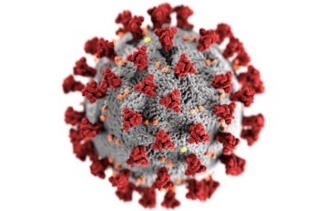Volume 16 Number 2
Editorial
Dr Kathy Hill and Fiona Donnelly
For referencing Hill K and Donnelly F. Editorial. Renal Society of Australasia Journal 2020; 16(2):34-35.
DOI https://doi.org/10.33235/rsaj.16.2.34-35

An illustration of a coronavirus
Image: CDC / Alissa Eckert, MS; Dan Higgins, MAM
It is impossible to imagine the future as we focus all of our efforts on the ‘right now’ in relation to the COVID-19 pandemic. Reported to be emerging in Hubei Province, China in November 2019, the first cases were seen in Australia and New Zealand in January 2020. This coronavirus is the 7th to infect humans, is a single RNA strand virus with avian and mammalian hosts, and is primarily spread through respiratory droplets (Oberfeld et al., 2020). We watched in distress as the pandemic placed unbelievable pressure on our colleagues, first in China, then Europe and then the USA. We saw field hospitals being built and mass mortality and when we were told to #stay home we could hardly wait to slam the door. But, as renal professionals, the door had to be opened again as we went out en masse into our respective health services to care for those afflicted by kidney disease and indeed those affected by COVID-19.
In Australia and New Zealand, due to rapid early enforced social isolation, we entered the initial virus containment phase early and effectively. Other countries in Asia, including Singapore, South Korea, Japan, Thailand and China, implemented the same social isolation and contract tracing policies to curb the spread. The initial spike in Australian and New Zealand cases slowed to a trickle and we drew a collective breath.
However, the virus had not gone away, it remained lurking and the urgency now lay in readying our health systems to cope and, in particular, ensuring adequate supplies of personal protective equipment (PPE). Field hospitals were built, manufacturing of PPE was ramped up and, in our home state, the government recommissioned a recently closed hospital for a dedicated COVID-19 centre.
Thousands of retired healthcare professionals or those working non-clinically signed up to join the health service again. AHPRA relaxed the very strict rules around lapsed registrations, and rightly so. We collected what can only be described as a health ‘reserve’ workforce.
Parallel to this we started to see the devastation of the social isolation measures on the thousands of workers who lost their employment, income and means to survive. Heart wrenching scenes of queues for unemployment benefits, our casual nursing workforce included who, due to the cancellation of elective surgery to increase hospital capacity, suddenly found themselves without work – unemployed renal and ICCU nurses... we would never have thought that could happen.
As the borders, not only around Australia and New Zealand but now internally from state to state closed, we had a seriously reduced capacity to share healthcare workers to the hardest hit areas, with enforced return to home state quarantine making this a challenging task for many.
The ANZSN formed a COVID-19 working group in collaboration with the RSA to provide national guidelines on managing renal units during the COVID-19 pandemic but, for many of our smaller units, implementing these would prove challenging. Integral to this plan was also ensuring that our suppliers could continue to produce essentially needed dialysis products to ensure that we did not see a shortage, making our already hard work even harder. This became particularly important when data emerged of the high prevalence of COVID-19 affected patients in ICCU developing acute kidney injury requiring dialysis (Hirsch et al., 2020). This COVID-19 working group has achieved two things – preparedness for the future and increased collaboration between the two societies.
Fast forward to July and we are experiencing yet more outbreaks and watching the evolving situation very closely. We hope that we are as prepared as we think we can be. The case numbers continue to build, and we cannot let our guard down. A team led by the Shanghai Public Health Clinical Center, China, shared the first genome sequence of the virus, initiating a global collaboration (Zastrow, 2020); the development of a much-needed vaccine will take a ‘big science’ approach with multilevel global collaboration (Berkley, 2020).
Management of COVID-19 in the meantime includes screening, isolation and supportive care (Oberfeld et al., 2020). Social distancing is more important than ever with the relaxing of social restrictions for bars and restaurants in some states that could see an increase in cases. The wonderful work of the ANZDATA registry in collating case number data tells us that, in the dialysis and transplant population, they are low to date, but we are alert to the possibility that this could change.
If you are a renal professional who has been involved in the care of a COVID-19 positive patient we encourage you to write your story and send it to the RSAJ to share with your colleagues. We have been contacted by our colleagues in Lombardi and we hope to share their story with you in the next edition of the RSAJ . In the meantime, remember we are a collective as renal health professionals and, in the current catchphrase environment, ‘we are all in this together’. We hope that you enjoy reading this issue of the RSAJ and continue to feel connected to colleagues all around Australia and New Zealand, and indeed the world.
Author(s)
Dr Kathy Hill PhD MPH GradCert (Neph) BN RN
Lecturer in Nursing
School of Nursing and Midwifery City East Campus
University of South Australia
Email Kathy.Hill@unisa.edu.au
Fiona Donnelly
President, RSAJ
Email president@renalsociety.org
References
Berkley, S. (2020). Covid 19 needs a big science approach. Science, 367(6485).
Hirsch, J.S., Ng, J.H., Ross, D.W., Sharma, P., Shah, H.H., Barnett, R.L... Northwell Covid-19 Research Consortium. (2020). Acute kidney injury in patients hospitalized with COVID-19. Kidney International, 98(1), 209–218. doi:10.1016/j.kint.2020.05.006
Oberfeld, B., Achanta, A., Carpenter, K., Chen, P., Gilette, N., Langat, P... Pillai, S. (2020). Snapshot: COVID 19. Cell, 181(4), 954–954.e1.
Zastrow, M. (2020). Open science takes on COVID 19. Nature, 581(7806), 109–110.
